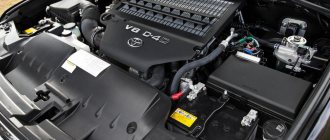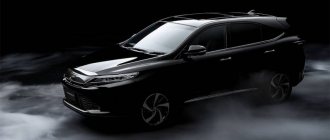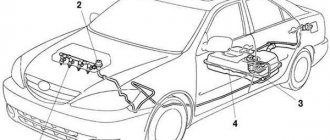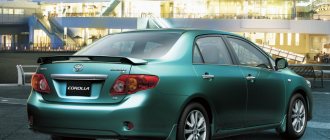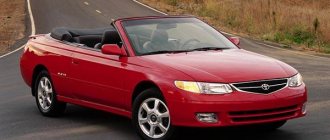Reliability of vehicle operation depends on the fuel used. Using low-quality fuel leads to serious problems. Modern electronic control units are capable of adjusting the power plant to the low-octane gasoline used by changing the ignition timing, which, however, entails increased wear of the power unit elements, as well as an increase in consumption.
The volume of the gas tank is affected by the size of the car, the weight of the vehicle, and power. SUVs and trucks are equipped with more capacious gas tanks compared to sedans, station wagons, and minivans. Regardless of the size, the fuel tank requires regular maintenance.
The volume of the Camry tank and fuel consumption are determining and interrelated factors in the reliability of vehicle operation.
Camry XV10 gas tank capacity
The tank volume of the Toyota Camry XV10 is 70 liters. According to the requirements established by the manufacturer, the fuel used is AI-95 gasoline. Fuel with an octane rating of 95 is recommended for refueling Toyotas with an automatic transmission or manual transmission.
Camry XV10
On a full tank, the Camry XV10 can travel about 540 km. This parameter is averaged and depends on the type of road, speed, driving style, and a number of other external factors. For example, fuel consumption of a 2.2 5S-FE with automatic transmission under ideal conditions should not exceed 11.2 liters. Actual consumption depends on weather conditions, the quality of the road surface, wear of the engine part, and so on. The appetite of the gasoline 3.0 3VZ-FE can reach 13.2 liters per hundred.
Cars with a manual transmission travel a longer distance with a full gas tank, unlike cars equipped with an automatic transmission. The reason for increased fuel consumption may be a failure of the sensor of the electronic engine control unit. In this case, the actual fuel consumption will not be displayed.
Camry XV20
Updates to the exterior and interior
The designers gave the sedan a predatory, aggressive character, which is typical of most modern cars. This impression is ensured by a massive grille air intake located in the lower zone.
The new model differs from its predecessor in having a shortened, embossed hood, and has received modified, strict headlights and a narrow radiator grille. Striking vertical fog lamps frame the air intake design. Notes of chic and presentability are added by chrome moldings.
The designers decided to improve visibility and equipped the car with narrow pillars in the rear and front. For the side zones, the designers used only stampings in the lower zone of the doors. Not only the hood has been shortened, but also the trunk lid.
The rear bumper is massive, the door is decorated with expressive stampings. The impressive lights are divided into two parts by the luggage cover. In general, the Toyota Camry 2017 model year looks presentable and solid.
The dimensions of the sedan have changed slightly. The wheelbase in the new body has been lengthened by a centimeter. The model dimensions are as follows:
- length – 4.85 m;
- width – 1.82 m;
- height – 1.48 m.
Russian motorists will be pleased with the increased ground clearance. For models that will be assembled for our market, it is 16 centimeters.
The interior of the 2021 Toyota Camry is luxurious and comfortable. The type of finish depends on the configuration. But even in basic sedans, only high-quality, high-quality materials are used. The selected shades are calm, noble, imparting solidity and elegance.
In order to create the most comfortable conditions for the driver, the designers changed the dashboard and increased the width to accommodate a solid on-board computer display. The multifunction steering wheel has become more comfortable.
The instrument panel is illuminated with a pleasant blue light. Therefore, sensor readings are clearly visible at any time of the day. Starter car models are equipped with everything you need: Bluetooth, WI-FI, USB port. Options are provided for tablets and smartphones running the Android operating system.
The interior is made presentable by natural wood elements on the doors, console, and glove compartment.
All seats are ergonomically designed to ensure comfort for every passenger, regardless of their size. The trunk volume, as in the previous model, is 506 liters. The designers have significantly increased sound insulation to ensure maximum comfort.
Camry XV20 gas tank
Camry XV20
The fuel tank volume of the Toyota Camry XV20 is no different from other models and is 70 liters. In this case, the 5S-FE motor can consume AI-92. An option to increase the reliability of the engine part, components and assemblies will be the use of AI-95. For example, 3.0 V6 1MZ-FE should be filled with AI-95 gasoline; the use of fuel with this octane number increases the service life of the engine and engine components.
Does tank capacity differ between different generations of cars?
The size of the fuel reserve (how many liters of fuel can be poured into the tank at a time) is an indicator that determines the driving distance without refueling. It depends on many factors. These are the design features of the vehicle, its weight, materials of manufacture and the provisions of regulations.
Different countries have implemented their own approaches to the production of cars, varying depending on the generation. The volumes of gas tanks also have their own standards.
Russian cars
The most popular domestic models on our roads are characterized by the following parameters:
- The volume of fuel tanks of VAZ cars has been steadily increasing over the years. If the classic versions had a limit of 39 liters, then the first 2108 sedans were already filled with 43 liters. Kalina and Granta have a fuel reserve of 50 dm³, Lada Vesta - 55 (in special configurations - up to 90) dm³.
- Passenger cars of the Gorky Automobile Plant were produced with a significant reserve of up to 70 liters of fuel.
- A UAZ, such as Hunter, fills up to 78 dm³. The classic model has a tank capacity of 56 liters, and the Patriot has 87 liters of fuel.
Japanese cars
Companies such as Toyota, Nissan and Honda have long set their designers an important task - reducing specific fuel consumption. As a consequence of a successful solution to this issue, there is a gradual minimization of refilled volumes.
Thus, Japanese cars of the first generations had gas tanks with a capacity of 50 liters. Then the fuel volume was reduced to 43-45 dm³, and modern models have 38 and even 32 liters. There is a gradual reduction in the volume of fuel to be filled due to increased efficiency.
American Toyota
There are more than a dozen factories in the United States where Toyota Motor Corporation cars are produced.
The most common model produced at these enterprises is Toyota. Since 1982, the car has been rolling off the production lines of the North American partners of the Japanese company.
Camry XV30
Camry XV30 before restyling
When answering the question of how many liters the Toyota Camry tank holds, it should be understood that the capacity of the gas tank of different bodies and trim levels does not differ - 70 liters. At the same time, the XV30 fuel type is gasoline with an octane rating of 95, according to the manufacturer’s recommendations. Under ideal fuel-to-fill fuel consumption conditions, the Camry XV30 can travel about 630 km when it comes to the 2.4, and 470 km if the engine is 3.0.
Toyota Camry XV40
The fuel tank capacity of the XV40 model is 70 liters. A full tank of the Toyota XV40 is enough to travel 540 km in city mode without refueling, if we are talking about a 2.4 engine. The full capacity with a 3.5 engine is enough to travel no more than 500 km. The fuel consumed in the first case is AI-95, in the case of V6 3.5 – AI-98.
Camry 40 is, without exaggeration, a cult car
The use of leaded gasoline is strictly prohibited, as it has an extremely negative effect on the power plant and catalyst.
Dream car © Engine capacity 30
That is, this model is intended for those people who are ready to pay quite a significant amount of money every day for the opportunity to drive their own Japanese car. Cars sold in Russia will differ from American ones, but the difference will not be as significant as before in the photo of cars for Russia and for America.
| Engine | Consumption (city) | Consumption (highway) | Flow (mixed) | Type of fuel |
| 1.3 MT 99 hp (Mechanics) | 6.7 | 4.7 | 5.4 | Petrol |
| 1.4 MT 90 hp (Mechanics) | 3.9 | 3.1 | 3.4 | Diesel |
| 1.4 AMT 90 hp (robot) | 5.8 | 4.4 | 4.9 | |
| 1.6 CVT 132 hp (variable speed drive) | 7.2 | 4.5 | 5.6 | Petrol |
| 1.6 MT 132 hp (Mechanics) | 7.9 | 4.8 | 5.8 | |
| 1.6 AT 132 hp (machine) | 9.1 | 5.8 | 7.0 | |
| 1.6 MT 109 hp (Mechanics) | 8.5 | 5.5 | 6.6 | |
| 1.6 AT 138 hp (machine) | 9.1 | 5.4 | 6.7 | |
| 1.8 CVT 134 hp (variable speed drive) | 3.6 | 3.5 | 3.6 | Hybrid |
| 2.0 MT 126 hp (Mechanics) | 5.4 | 4.0 | 4.5 | Diesel |
| 2.2. MT 177 hp (Mechanics) | 7.8 | 5.1 | 6.1 |
Camry XV50
The tank capacity of the Toyota Camry XV50 with any engine is 70 liters. Consumption in the urban cycle for the 2.0 will be 10 liters, for the 2.5 engine – 11 liters, and for the V6 3.5 – 13.2 liters per hundred.
Black Camry - classic
Consumption when driving on the highway is reduced relative to the urban driving cycle of the car. Provided the vehicle is in good technical condition, consumption is affected only by external factors and driving style.
Interior
For example, a steering wheel with a plastic rim is installed, there are no rain or parking sensors, and a simplified radio with a CD player and radio is used. The model is offered with engines of 2.5 and 3.5 liters; versions with a V-engine are distinguished by advanced equipment, such as electric drives for adjusting the steering column and rear seat.
Toyota Camry XV70
The type of fuel consumed by the XV70 is AI-92. The manufacturer recommends using gasoline with an octane rating of 92 to refuel the XV70 with any power unit. Fuel consumption in the urban cycle will be 9.7 liters if we are talking about 2.0. 11.5 liters are consumed per 100 km when the engine displacement is 2.5. 12.5 liters are spent per hundred with V6 3.5.
Gas tank - 60 liters.
A sharp increase in fuel consumption indicates a technical malfunction. Most often, the engine part, ignition elements, injectors or air filter are to blame. Often the problem is the fuel tank itself. To avoid leakage, manufacturers make multilayer tank walls, however, even in this case, the car owner is not 100% insured against leakage.
How to reduce gasoline consumption
The first thing to do is change your driving style. Reduce the number of accelerations and braking, drive the car smoothly, maintaining a constant speed if possible.
With a manual transmission, you should change gears on time, try to move in fourth or fifth at 60-70 km/h.
It is necessary to monitor the technical condition of the car. Change spark plugs, fuel and air filters not based on extreme wear, but according to the maintenance schedule. Correct wheel alignment adjustment and tire pressure monitoring will save up to hundreds of liters of fuel annually.
The correct selection of engine oil is not the last factor. Reducing friction between parts of the power plant will also reduce fuel consumption.

